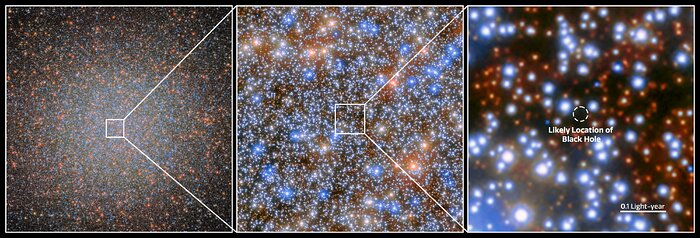IMBH candidate in Omega Centauri
An international team of astronomers has used more than 500 images from the NASA/ESA Hubble Space Telescope spanning two decades to detect seven fast-moving stars in the innermost region of Omega Centauri, the largest and brightest globular cluster in the sky. These stars provide compelling new evidence for the presence of an intermediate-mass black hole (IMBH).
This image shows the location of the IMBH in Omega Centauri. If confirmed, at its distance of 17 700 light-years the candidate black hole resides closer to Earth than the 4.3 million solar mass black hole in the centre of the Milky Way, which is 26 000 light-years away. Besides the Galactic centre, it would also be the only known case of a number of stars closely bound to a massive black hole.
[Image Description: This image presents three panels. The first image shows the global cluster Omega Centauri, appearing as a highly dense and numerous collection of shining stars. The second image shows the details of the central region of this cluster, with a closer view of the individual stars. The third image shows the location of the IMBH candidate in the cluster.]
Credit:ESA/Hubble & NASA, M. Häberle (MPIA)
About the Image
| Id: | heic2409b |
|---|---|
| Type: | Chart |
| Release date: | 10 July 2024, 17:00 |
| Related releases: | heic2409 |
| Size: | 6648 x 2260 px |
About the Object
| Name: | Omega Centauri |
|---|---|
| Distance: | 17000 light years |
| Category: | Stars |
Image Formats
Wallpapers
Colours & filters
| Band | Wavelength | Telescope |
|---|---|---|
| Ultraviolet UV | 275 nm |
Hubble Space Telescope
WFC3 |
| Optical U | 336 nm |
Hubble Space Telescope
WFC3 |
| Optical B | 438 nm |
Hubble Space Telescope
WFC3 |
| Optical r | 625 nm |
Hubble Space Telescope
WFC3 |
| Optical V | 625 nm |
Hubble Space Telescope
WFC3 |
| Optical V | 625 nm |
Hubble Space Telescope
ACS |
| Optical N II | 658 nm |
Hubble Space Telescope
WFC3 |
| Optical I | 814 nm |
Hubble Space Telescope
WFC3 |
| Optical I | 814 nm |
Hubble Space Telescope
ACS |
